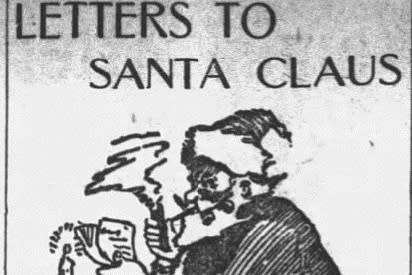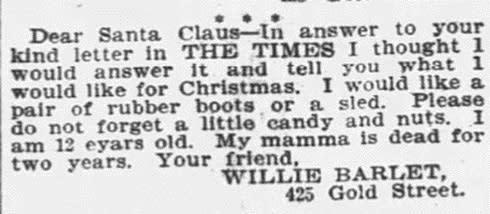How a scrappy Buffalo newspaper saved Christmas and sparked a movement
When people unfolded their copies of the Buffalo Times on Dec. 6, 1898, they read news of a diamond heist, a double divorce and a deadly boating accident in Algiers. But there, at the bottom of the front page, was something truly unexpected: a letter from Santa Claus.
The adults understood the wink behind "with the help of many unknown good people." But 1898 was a tough year for Christmas presents. The country had recently emerged from a financial crisis, and the unemployment rate was still stuck in the double digits. A holiday miracle would be needed for many of the kids of Buffalo to get their wishes.
And then one came. Three days later, in a small column on page 5 titled "Letters to Santa Claus," the Times began printing the children's requests.
Some newspapers had previously published letters to Santa, but mostly in unserious or dismissive ways. The Evansville Courier and Press in 1897 proposed demystifying Santa Claus entirely, concluding that "if the moral development of the future generations is to be considered," Santa should exist "only in story."
The Times's effort was different: It was front-page business. The column presented the letters verbatim, stating that "it is to be hoped that some of the liberal people of Buffalo and vicinity will imitate Santa Claus" and respond directly to the letters, which were printed with full names and addresses.
Most of the letters were short, though some suggested grown-up involvement ("With eager eyes I have long looked for Christmas"). Some of the submissions were parentally transcribed ("my mammy is holding my hand") while some proudly were not ("This is my own handwriting"; "My hand is very tired now"). They were sincere, filled with requests, promises and even directions.
Many made requests for their brothers and sisters, though some siblings wrote in separately.
Most were practical and humble.
Some probably went too far, but hey, it was Christmas.
Some had a sting.
Some were hard to read.
Within days, the letters grew from a small column to a full-page spread. Letters began to drift in like snow. As Christmas week approached, the Times had received nearly 4,000 of them. The children closed their letters with "your little friend," "your true companion" and "do not forget me."
The Times reported a few times that people had swooped in to give gifts, but it was otherwise quiet on whether the letters were prompting any action. (One response the paper did receive came from a woman who scolded her granddaughter for claiming in a letter to be poor - she was not, assured grandma.) But time was running out, and the letters kept coming. They now appeared across three full pages of tiny print. Could Santa really do the impossible?
On Dec. 23, Santa returned to the Times with a new letter. St. Nick wrote that the Times editor had sent him all the letters, but there were just too many. "So," Santa wrote, "I have asked him to help me out."
The Times announced that there would be a Christmas party for all who had sent letters to Santa. The children were promised "some little gift as evidence" that Santa Claus had read their letters. For so many who had sent in letter, it felt like a miracle.
On the day of the party, people began lining up early. Five thousand children and their parents came. They were given popcorn balls, steam engines, toy kitchens and whistles. One happy boy finally got the sword he wanted. The Times had purchased all the gifts.
"Not one of the little ones who attended were forgotten," the paper reported afterward.
The editor of the Times was Norman E. Mack, who had founded it 10 years earlier and seen it through its early years, when money was so tight that reporters waited around to be paid by pennies brought in from the newsboys. Mack was known as a kindhearted editor who bought stories from poor writers even if they were destined for the wastebasket. When the staff surprised him with a gold watch for Christmas, he took them all out to dinner.
But the letters project came not from Mack, the Times revealed, but from the paper's city editor, who hoped to use letters to Santa as a vehicle for charity.
On Christmas Day, the Times finally ran a small success story. It was about the Siemen family, who lived in the rear of 164 Walnut St. The three children, Marvin, 8, Birdie, 6 and Leah 4, all had spinal problems. Their father was "a huckster" who slept on the floor with his wife because the expense of a mattress would prevent them from paying the medical bills.
J.N. Ayer, a door-to-door political canvasser, had been so affected by the family's plight that he had written a letter to Santa in the Times. Miss Benson, a teacher at Masten Park High School, saw the letter, and her class volunteered to help the family. On Christmas Eve, two girls from the class showed up at the apartment with baskets full of toys, clothing and food. There were tears as they handed the gifts to the family.
"What funny Santa Clauses those were," said Birdie, the Times reported. "They didn't have reindeers or whiskers or bells or anything."
The Times continued running the letters for a few years. Other papers tried different versions. The Pittsburgh Press worked with a toy charity. The Sioux City Journal ran a contest for the "best letter" in 1899. The St. Louis Dispatch and Indianapolis Star had Christmas funds. The Brooklyn Daily Eagle ran Santa letters without addresses. Other papers, like the Atlanta Journal and the Knoxville Sentinel, printed swaths of letters, sometimes with a brief letter from Santa promising that children would receive everything they asked for if they had been good.
In 1909, the Times ran a sad story under the headline "Santa Claus a stranger," relaying the news that Postmaster General Frank Hitchcock decided that all letters to Santa received in the U.S. mail would be sent to the Dead Letter Office, where they would eventually be destroyed.
Days after Hitchcock's bleak announcement appeared in newspapers nationwide, he rescinded the order and announced that all letters to Santa would be forwarded to charities. This was the spark of Operation: Santa, the ongoing national effort to enable ordinary citizens to help Santa answer his letters every Christmas.
In addition to his duties as postmaster, Hitchcock was head of the Republican National Committee from 1908 to 1909. His counterpart on the Democratic National Committee during that time was Norman Mack, who died in 1932 on the day after Christmas.
- - -
Brad Ricca is the award-winning author of six books.
Related Content
Her story fueled anti-trans bills. Now, she's fighting them.
Michael Bennet's family fled the Nazis. Now, he won't give up on Ukraine.
Barbie, the Titan submersible and everything else we Googled in 2023





